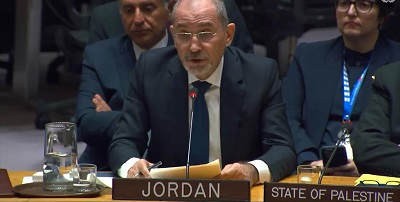How Latin America should navigate US-China tensions - By Felipe Larraín and Pepe Zhang, The Jordan Times
SANTIAGO — Once a peripheral presence in Latin America, China has become one of the region’s most important partners. Bilateral trade expanded from $12 billion in 2000 to over $300 billion in 2020, raising China’s share of the region’s total trade from 1.7 per cent to 14.4 per cent. China has also become an increasingly significant source of foreign direct investment in Latin America, accounting for nearly 10 per cent of inflows in recent years.
Growing Chinese influence in the Western Hemisphere has not gone unnoticed by the United States. With no reset in sight for US-China relations, the rivalry between the world’s two largest economies and trading countries continues to escalate globally and in Latin America.
In the short term, the politicisation of COVID-19 vaccine access could become the latest trigger for renewed Sino-American tensions. Over the medium and long term, perhaps as soon as 2035 — China could replace the US as the region’s largest trading partner. The country is already the top trade partner of Brazil, Peru and Chile, and receives 30-40 per cent of their exports.
In this context, the key question for Latin America is whether the region can successfully adapt to, or even benefit from, the persistent competitive dynamics between the US and China. But the answer remains at best mixed and unclear, in part owing to significant differences across the region.
Consider the US-China trade war, which escalated in March 2018 with the first round of retaliatory tariffs. Although Brazil’s soybean exporters have realised sizable gains over the last three years by replacing US exports to China, other Latin American countries and sectors did not necessarily benefit from trade diversion to the same extent. Even in Brazil, there is uncertainty as to the long-term sustainability of the export boom triggered by the trade war.
Moreover, northern Latin America (Mexico, Central America, and the Caribbean) has markedly different trade relations with China compared to the region’s commodity-dependent south. While Mexico previously captured reshoring and nearshoring opportunities as some supply chains shifted out of China, the COVID-19 pandemic wiped out much of that windfall, at least temporarily.
Latin American economies are susceptible to the indirect spillovers of trade wars as well. On a macro level, the region is among the worst affected by the pandemic in human and economic terms. Latin America accounts for only 8 per cent of the world’s population yet consistently represents 30 per cent of COVID-19 deaths, and in 2020 it suffered the deepest economic contraction of any developing region. Continued US-China tensions may put additional downward pressure on an already uncertain global and regional recovery.
On a micro level, retaliatory tariffs and growing protectionism triggered by the trade war have caused collateral damage for Latin American firms. In 2019, for example, Chilean nut exporters were caught off guard when the Indian government increased most-favored-nation tariffs on nuts in response to bilateral US tariffs on Indian steel. This decision affected a Chilean shipment of nuts already at sea en route to India.
With Latin America facing a potentially unsupportive international environment, owing to divergent post-pandemic recoveries and sustained US-China trade frictions, policymakers should pursue three priorities.
First, Latin American countries must remain vigilant and carefully navigate US-China tensions on issues ranging from trade and investment to 5G technology and COVID-19 vaccines. The region is highly heterogeneous, especially between its north and south, so the only rule of thumb for choosing between the US and China (which many regard as a false dichotomy) should be alignment with national development goals and strategies.
Second, Latin America needs to diversify its exports, starting at the country level. Embracing greater trade openness globally and intra-regionally reduces dependence on individual markets, whether the US or China. Despite widespread protectionism, exacerbated by pandemic-induced export controls, Latin America can play a constructive role in strengthening international trade cooperation. Chile, for example, which has 26 trade agreements with over 60 countries, is a regional and global free-trade champion.
Lastly, the region should explore ways to boost its long-term export competitiveness. Lowering tariff and non-tariff barriers (including through infrastructure and regulatory improvements) and seizing the opportunities presented by the Fourth Industrial Revolution will be instrumental in reducing export costs. Effective trade promotion and facilitation measures would not only help to mitigate the impact of trade-war spillovers, but also would support export diversification and development. Governments should complement these measures with supportive domestic policies to ensure the distributional benefits of trade.
US-China tensions are unlikely to abate anytime soon, and Latin America will not be able to insulate itself fully from the fallout. But by heeding the lessons of the last three years, the region’s governments and businesses can better position themselves to succeed over the next three years and beyond.
Felipe Larraín B., a former minister of finance of Chile (2010-14 and 2018-19), is professor of Economics at Universidad Católica de Chile and a member of the Lancet COVID-19 Commission, the United Nations Leadership Council for Sustainable Development, and the Atlantic Council’s Adrienne Arsht Latin America Centre’s Advisory Council. Pepe Zhang, Associate director of the Atlantic Council’s Adrienne Arsht Latin America Centre, is co-author of China-LAC Trade: Four Scenarios in 2035 and LAC 2025: Three Post-COVID Scenarios. Copyright: Project Syndicate, 2021. www.project-syndicate.org
Latest News
 Israeli Occupation strike inside Iran responds to Tehran's provocation, reports say
Israeli Occupation strike inside Iran responds to Tehran's provocation, reports say Blinken highlights urgency for enhanced humanitarian aid in Gaza Strip
Blinken highlights urgency for enhanced humanitarian aid in Gaza Strip Senate president, British ambassador discuss strategic partnership, regional stability
Senate president, British ambassador discuss strategic partnership, regional stability Jordan urges UN to recognise Palestine as state
Jordan urges UN to recognise Palestine as state Safadi, Iranian counterpart discuss war on Gaza, regional escalation
Safadi, Iranian counterpart discuss war on Gaza, regional escalation
Most Read Articles
- Jordan urges UN to recognise Palestine as state
- Senate president, British ambassador discuss strategic partnership, regional stability
- JAF carries out seven more airdrops of aid into Gaza
- Temperatures to near 40 degree mark next week in Jordan
- Safadi, Iranian counterpart discuss war on Gaza, regional escalation
- US vetoes Security Council resolution on full Palestinian UN membership
- UN chief warns Mideast on brink of ‘full-scale regional conflict’
- Biden urges Congress to pass 'pivotal' Ukraine, Israel war aid
- Google fires 28 employees for protesting $1.2 billion cloud deal with “Israeli” army
- Israeli Occupation strike inside Iran responds to Tehran's provocation, reports say